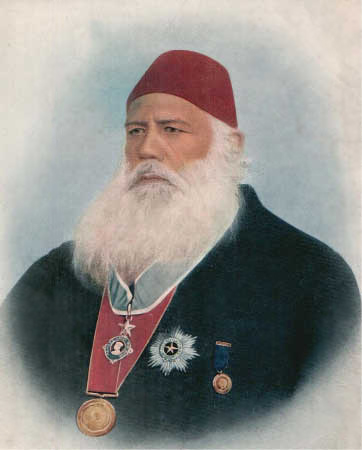Source: Sir Syed A. Khan quoted in Jain, M. (2010). Parallel pathways: Essays on Hindu-Muslim relations, 1707-1857. quoting Ashraf 2007, also in 1857 in the Muslim Historiography, Muḥammad Ikrām Cug̲h̲tāʼī. also in Rebellion 1857 A Symposium (1957)" https://archive.org/stream/in.ernet.dli.2015.52043/2015.52043.Rebellion-1857-A-Symposium-1957_djvu.txt
Famous Syed Ahmed Khan Quotes
quoted in Arun Shourie - The World of Fatwas Or The Sharia in Action (2012, Harper Collins)
Quoted in Shirali, Aresh (10 August 2017). "The Enigma of Aligarh" https://openthemagazine.com/freedom-issue-2017/freedom-issue-2017-dispatches-from-history/the-enigma-of-aligarh/. Open Magazine.
Variant: "India is like a bride which has got two beautiful and lustrous eyes—Hindus and Mussulmans. If they quarrel against each other that beautiful bride will become ugly and if one destroys the other, she will lose one eye." Writings and Speeches of Sir Syed Ahmad Khan https://books.google.com/books?id=ausHAAAAMAAJ, p. 160.
Azhar Mohammed New Age Islam http://www.newageislam.com/NewAgeIslamIslamicPersonalities_1.aspx?ArticleID=1955
About
About antiquities of Delhi. Translated from the Urdu of Asaru’s-Sanadid, edited by Khaleeq Anjum, New Delhi, 1990. Vol. I, p. 305-16
Asaru’s-Sanadid
Quoted from After a Century it is time to revisit Sir Syed Ahmad Khan’s legacy https://www.myind.net/Home/viewArticle/after-a-century-it-is-time-to-revisit-sir-syed-ahmad-khans-legacy Avatans Kumar Jan 27, 2018. Also quoted in The Great Speeches of Modern India by Rudranghsu Mukherjee
Syed Ahmed Khan Quotes
M.R.A. Baig, The Muslim Dilemma in India, Delhi, 1974, p. 52.
About
Quoted from After a Century it is time to revisit Sir Syed Ahmad Khan’s legacy https://www.myind.net/Home/viewArticle/after-a-century-it-is-time-to-revisit-sir-syed-ahmad-khans-legacy Avatans Kumar Jan 27, 2018. Also quoted in The Great Speeches of Modern India by Rudranghsu Mukherjee
Quoted from After a Century it is time to revisit Sir Syed Ahmad Khan’s legacy https://www.myind.net/Home/viewArticle/after-a-century-it-is-time-to-revisit-sir-syed-ahmad-khans-legacy Avatans Kumar Jan 27, 2018 . Also in A Tale of Two Revolts by Rajmohan Gandhi
Sir Syed Ahmed Khan (1817–1898), Speech in March 1888, Quoted by Dilip Hiro, "The Longest August: The Unflinching Rivalry Between India and Pakistan" https://yaleglobal.yale.edu/longest-august-unflinching-rivalry-between-india-and-pakistan
KUMAR, S (2000). Educational Philosophy in Modern India. Anmol Publications Pvt. Ltd. p. 60.
Source: Quoted from After a Century it is time to revisit Sir Syed Ahmad Khan’s legacy https://www.myind.net/Home/viewArticle/after-a-century-it-is-time-to-revisit-sir-syed-ahmad-khans-legacy Avatans Kumar Jan 27, 2018
quoted in Arun Shourie - The World of Fatwas Or The Sharia in Action (2012, Harper Collins)
quoted in Vikram Sampath - Savarkar, Echoes from a Forgotten Past, 1883–1924 (2019)
... “Our nation is of the blood of those who made not only Arabia, but Asia and Europe, to tremble. It is our nation which conquered with its sword the whole of India, although its peoples were all of one religion.”
Quoted from After a Century it is time to revisit Sir Syed Ahmad Khan’s legacy https://www.myind.net/Home/viewArticle/after-a-century-it-is-time-to-revisit-sir-syed-ahmad-khans-legacy Avatans Kumar Jan 27, 2018. Also quoted in The Great Speeches of Modern India by Rudranghsu Mukherjee
Writings and Speeches of Sir Syed Ahmad Khan https://www.google.com/books/edition/Writings_and_Speeches/ausHAAAAMAAJ?hl=en, Nachiketa Publications (1972), p. 160.
Variant: "India is a beautiful bride and Hindus and Muslims are her two eyes. If one of them is lost, this beautiful bride will become ugly." Quoted in Shirali, Aresh (10 August 2017). "The Enigma of Aligarh" https://openthemagazine.com/freedom-issue-2017/freedom-issue-2017-dispatches-from-history/the-enigma-of-aligarh/. Open Magazine.
